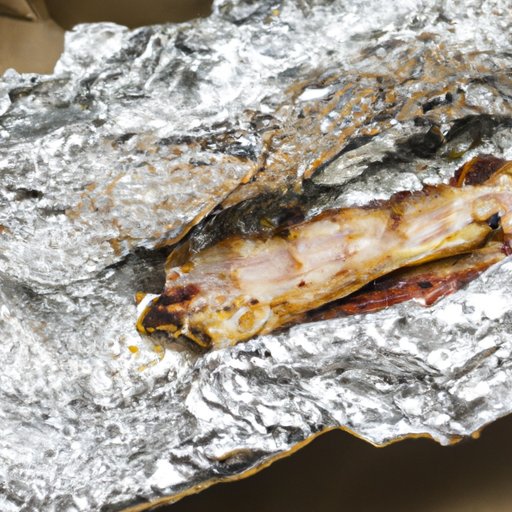I. Introduction
Cooking bacon can be messy and time-consuming, especially when it’s done on a stovetop. Many people are turning to cooking bacon in the oven for a quick, no-fuss option. However, there are still some issues that need to be addressed, such as sticking and overcooking. This article will provide a step-by-step guide on how to cook bacon in the oven using aluminum foil. In addition, it’ll also compare and contrast oven-cooked bacon with pan-fried bacon, provide creative recipes, and give health-related insights into cooking with aluminum foil.
II. Step by Step Instructions
Achieving a crispy and tasty bacon requires following these steps:
A. Preparing the bacon
Start by selecting fresh, high-quality bacon for the best results. Remove the bacon from the packaging and let it come to room temperature for 30 minutes. This ensures that the bacon cooks evenly, from the center to the edges.
B. Setting up the foil
Cover a baking sheet with a piece of foil that’s slightly larger than the baking sheet. This ensures that no grease will seep through the foil and onto the baking sheet, which will make cleanup easier. Place a wire baking rack on top of the foil. This allows the bacon to cook evenly, without sticking to the foil.
C. Cooking times and temperatures
Preheat your oven to 400°F. Lie the bacon strips on the wire rack, ensuring that they don’t overlap each other. Bake the bacon for 15-20 minutes, depending on your desired level of crispiness. Remove the bacon from the oven when it’s golden brown and crispy. Let it cool for a few minutes before enjoying.
D. Precautions and safety measures
Be mindful of the splatters and the hot grease while cooking bacon, make sure to use mitts and kitchen tongs. Don’t discard the bacon fat immediately, allow it to cool before disposing of it.
III. Comparing and Contrasting Oven-cooked Bacon with Pan-fried Bacon
A. Taste and Texture
Oven-cooked bacon tends to have a more consistent texture, and it’s less greasy compared to pan-fried bacon. However, pan-fried bacon is known for its crispy and charred bits, which some people enjoy. The overall taste will depend on personal preference.
B. Convenience
Oven-cooked bacon is less hands-on and more convenient as it requires less monitoring compared to stove top. It also frees up your stove top for other dishes. However, pan-fried bacon is ideal when cooking small amounts of bacon and when you want to control the crispiness to your preference.
C. Benefits of using Aluminum Foil
Aluminum foil is non-stick, which makes it easy to remove the bacon from the foil without sticking. It also protects your baking sheet from grease and makes the cleanup process faster and less messy. Be sure to dispose of the used foil appropriately.
IV. Tips for Avoiding Common Mistakes
A. Sticking to the foil
If the bacon greases stick to the foil, try coating the foil lightly with a non-stick cooking spray. Also, it’s crucial to ensure that the bacon strips don’t overlap or touch each other during cooking
B. Overcooking the bacon
Bacon can become too crispy or burnt if overcooked, monitor the oven temperature often, and adjust the cooking time based on your desired level of crispiness.
C. Adjusting cooking times and temperature
Finally, if you’re cooking in bulk or using a thicker bacon cut, you may need to adjust the cooking time or temperature accordingly.
V. Creative and Tasty Bacon Recipes
A. Bacon Wrapped Dates
Ingredients: Thin bacon slices, Pitted dates, Balsamic reduction.
Preheat your oven to 400°F. Wrap each pitted date with a slice of bacon, and secure with a toothpick. Place the wrapped dates on a baking sheet lined with foil. Bake for 12-15 minutes, until crispy and the bacon is cooked to your preference. Drizzle with balsamic reduction and serve.
B. Maple-glazed Bacon
Ingredients: Smooth maple syrup, Brown sugar, Smoked paprika, Thin bacon slices.
Preheat your oven to 350°F. In a bowl, combine maple syrup, brown sugar, and smoked paprika. Take each bacon strip and coat it evenly in the mixture, then place it on a baking rack on top of a foil-lined baking sheet. Bake for 20 minutes, or until the bacon is golden and crispy. Let cool and serve.
VI. Health-related Insights of Oven-cooked Bacon using Aluminum Foil
A. Reduction of Fat
Cooking bacon in the oven using aluminum foil allows for the separation of the bacon fat from the bacon, which results in less fat intake. This lowers the total fat content and reduces the overall calories intake.
B. Minimizing Splatters
Cooking bacon in the oven is less likely to splatter and cause grease burns, allowing for a safer and healthier cooking experience.
VII. Comparison of Aluminum Foil vs Parchment Paper vs Baking Sheet
A. Pros and Cons
Aluminum foil and parchment paper are both non-stick, making them ideal for cooking bacon in the oven. However, while aluminum foil can withstand higher temperatures, parchment paper tends to burn at high heat when exposed for too long. A baking sheet is ideal for cooking bacon using the infrared method when placed on top of a non-stick baking mat. All options have their pros and cons.
B. Choosing the best method for personal preference and situation
Choose a method that suits your intended result, cooking time, temperature and the quantity of bacon needed. Oven-cooked bacon is ideal for cooking large quantities, while the stovetop is great for smaller portions and precision control.
VIII. Conclusion
A. Recap of the topics covered
This article has provided step-by-step instructions on cooking bacon in the oven using aluminum foil, comparison with pan frying, creative and delicious recipes, health-related insights, and compared and contrasted foil vs. parchment paper vs. baking sheet.
B. Final thoughts on the advantages of cooking bacon in the oven using aluminum foil.
Cooking bacon using aluminum foil is convenient and mess-free, compared to pan-frying. It’s also healthier and allows you to achieve your desired level of crispiness consistently.
